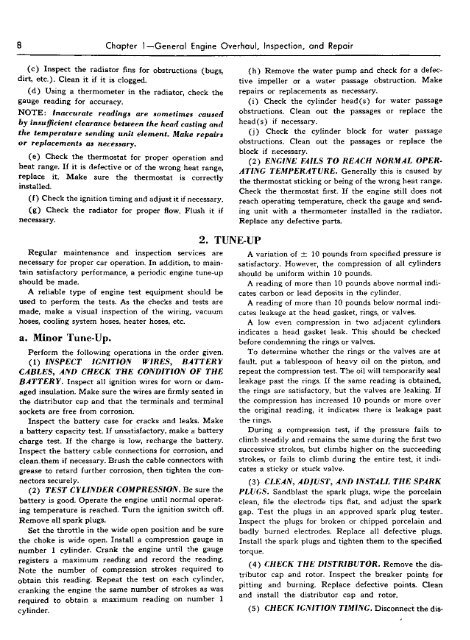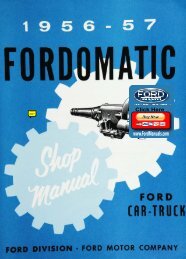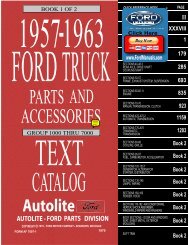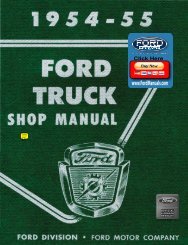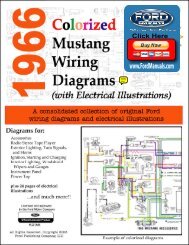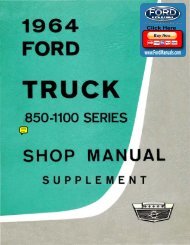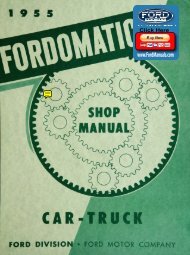8 Chapter 1 General Engine Overhaul, Inspection, and Repair(c) Inspect the radiator fins for obstructions (bugs,dirt, etc.). Clean it if it is clogged.(d) Using a thermometer in the radiator,gauge reading for accuracy.check theNOTE: Inaccurate readings are sometimes causedby insufficient clearance between the head casting andthe temperature sendingunit element. Make repairsor replacements as necessary.(e)Check the thermostat for proper operation andheat range. If it is defective or of the wrong heat range,replace it. Make sure the thermostat is correctlyinstalled.(f) Check the ignition timing and adjust it if necessary.(g)necessary.Check the radiator for proper flow. Flush it if(h) Remove the water pumpand check for a defective impeller or a water passage obstruction. Makerepairs or replacements as necessary.(i) Check the cylinder head(s) for water passageobstructions. Clean out the passages or replace thehead(s)if necessary.(j) Check the cylinder blockfor water passageobstructions. Clean out the passages or replace theblock if necessary.(2)ATING TEMPERATURE. Generally this is caused byENGINE FAILS TO REACH NORMAL OPERthe thermostat sticking or being of the wrong heat range.Check the thermostat first. If the engine still does notreach operating temperature,ingReplace any defective parts.check the gauge and sendunit with a thermometer installed in the radiator.2. TUNE-UPRegular maintenance and inspection services arenecessary for proper car operation. In addition, to maintain satisfactory performance, a periodic engine tune-upshould be made.A reliable type of engine test equipment should beused to perform the tests. As the checks and tests aremade, make a visual inspection of the wiring, vacuumhoses, cooling system hoses, heater hoses, etc.a. Minor Tune-Up.Perform the following operations in the order given.(1) INSPECT IGNITION WIRES, BATTERYCABLES, AND CHECK THE CONDITION OF THEBATTERY. Inspect all ignition wires for worn or damaged insulation. Make sure the wires are firmly seated inthe distributor cap and that the terminals and terminalsockets are free from corrosion.Inspect the batterycase for cracks and leaks. Makea battery capacity test. If unsatisfactory, make a batterycharge test. If the charge is low, recharge the battery.Inspect the battery cable connections for corrosion, andclean.them if necessary. Brush the cable connectors withgrease to retard further corrosion, then tighten the connectors securely.(2)batteryingTEST CYLINDER COMPRESSION. Be sure theis good. Operate the engine until normal operattemperature is reached. Turn the ignition switch off.Remove all spark plugs.Set the throttle in the wide open position and be surethe choke is wide open. Install a <strong>com</strong>pression gauge innumber 1cylinder. Crank the engine until the gaugeregisters a maximum readingand record the reading.Note the number of <strong>com</strong>pression strokes required toobtain this reading. Repeat the test on each cylinder,crankingthe engine the same number of strokes as wasrequired to obtain a maximum readingcylinder.on number 1A variation of10 pounds from specified pressure issatisfactory.However, the <strong>com</strong>pression of all cylindersshould be uniform within 10 pounds.A reading of more than 10 pounds above normal indicates carbon or lead deposits in the cylinder.A reading of more than 10 pounds below normal indicates leakage at the head gasket, rings, or valves.A low even <strong>com</strong>pression in two adjacent cylindersindicates a head gasket leak. This should be checkedbefore condemning the rings or valves.To determine whether the rings or the valves are atfault, put a tablespoon of heavy oil on the piston, andrepeat the <strong>com</strong>pression test. The oil will temporarily sealleakage past the rings. If the same reading is obtained,the rings are satisfactory, but the valves are leaking. Ifthe <strong>com</strong>pression has increased 10 pounds or more overthe original reading, it indicates there is leakage pastthe rings.During a <strong>com</strong>pression test, if the pressure fails toclimb steadily and remains the same during the first twosuccessive strokes, but climbs higher on the succeedingstrokes, or fails to climb during the entire test, it indicates a sticky or stuck valve.(3) CLEAN, ADJUST, AND INSTALL THE SPARKPLUGS. Sandblast the spark plugs, wipe the porcelainclean, file the electrode tips flat, and adjust the sparkgap. Test the plugs in an approved spark plug tester-Inspect the plugs for broken or chipped porcelain andbadly burned electrodes. Replace all defective plugs.Install the spark plugs and tighten them to the specifiedtorque.(4) CHECK THE DISTRIBUTOR. Remove the distributor cap and rotor. Inspect the breaker points forpitting and burning. Replace defective points. Cleanand install the distributor cap and rotor.(5) CHECK IGNITION TIMING. Disconnect the dis-
Section 2 Engine Tune-Uptributor vacuum line. Operate the engine at idle speed.Check the timing with a timing light and make thenecessary adjustments. Connect the distributor vacuumline.(6) CHECK MANIFOLD VACUUM AND ADJUSTCARBURETOR IDLE. Check the manifold vacuum atthe specified idle speed.If the vacuum is lower than specified, check for leakage at the vacuum lines and intake manifold. Check thecarburetor idle adjustment.If the vacuum is still below normal or is erratic, it isan indication of bad rings, sticky valves, weak valvesprings, or a head gasket leak.Set the engine idle speed and the carburetor idle fueladjustment as outlined in Chapter IV.(7) CLEAN THE AIR CLEANER AND THE FUELFILTER. Clean the air cleaner, and oil the element. Ifthe air cleaner is the oil bath-type, fill to the indicatedlevel with engine oil of the specified viscosity.On passenger cars, remove and clean the fuel pumpbowl. Install a new filter element.On Thunderbirds,new filter element.(8)clean the fuel line filter. Install aCHECK THE DEFLECTION OF THE DRIVEBELTS. Check the deflection of all drive belts (fan,air conditioning,sary adjustments.b. Major Tune-Up.Perform the followingand power steering). Make the necesoperations in the order given.(1)Clean the battery terminals and cable connectors. Inspect the battery case for cracks and leaks. Make abattery capacity test. If unsatisfactory, make a batteryBATTERY. Remove the cables from the battery.charge test. If the charge is low, recharge the "battery.Replace deteriorated connectors and cables that haveworn insulation. Brush the cable connectors with greaseto retard further corrosion. Connect the cables to thebattery.CHECK THE GENERATOR AND REGULA(2)TOR. Follow the procedures outlined in Part THREE,"Electrical and(3)Accessories."TEST SPARK INTENSITY. Determine if thespark from each plug wire will jump a 3/16 inch gap, asfollows:Remove one spark plug wire,and install a terminaladapter in the wire terminal. Hold the end of theadapter approximately 3/16inch from the cylinder head.Run the engine at idle speed. The spark should jumpthe regularly.gapRepeat the test on each lead.If the spark is unsatisfactory at all spark plugs,trouble exists in the coil, condenser, rotor or cap, internally in the distributor, or in the external primarycircuit.If the spark is unsatisfactory at some,but not all ofthe spark plug wires, the trouble is in the wire itself,the wire is not seated in the housing socket, or thedistributor cap is corroded.(4)TEST CYLINDER COMPRESSION. Follow theprocedure under "a. Minor Tune-Up."(5) CLEAN, ADJUST, AND INSTALL SPARKPLUGS. Sandblast the spark plugs, wipe the porcelainclean, file the electrode tips flat, and adjust the gap.Test the plugs in an approved tester. Inspect the plugsfor broken or chipped porcelain and badly burnedelectrodes. Replace all defective plugs. Install the plugsand tighten them to the specified torque.(6)CHECK MANIFOLD BOLT TORQUE. Tightenthe intake and exhaust manifold bolts and nuts to 23-28foot-pounds torque.(7) TEST COIL AND CONDENSER. If the sparkintensity (3) is satisfactory, it will not be necessary totest the coil and condenser. However, if the spark isnot satisfactory,test these parts on a test unit to determine which one is defective. Follow the instructions ofthe test unit manufacturer.(8) INSPECT BREAKER POINTS AND TESTTHE DISTRIBUTOR. Inspect the distributor pointsfor pits, excessive metal transfer,and burned spots.Test the vacuum advance and make adjustments,repairs, or replacements as required. Set the point gapto specifications. After setting the gap,check the pointdwell. If the dwell angle is not to specifications, thedistributor cam is worn or the point assembly is defective. Replace all defective parts. Lubricate the distributor cam lightlywith distributor cam lubricant.(9)CLEAN AND INSPECT THE DISTRIBUTORCAP. Inspect the capfor cracks or other damage. Remove all corrosion from the terminal housing sockets.(10)CHECK IGNITION TIMING. Disconnect thevacuum line between the distributor and carburetorand operate the engine at idle speed. Check the timingwith a timing light and make the necessary adjustments.Connect the distributor vacuum line after <strong>com</strong>pletingthe adjustment and check ignition advance as the engine is accelerated.(11)CHECK AND ADJUST VALVE LASH. Checkand adjust the valve lash after the engine is thoroughlywarmed up.(12)TEST MANIFOLD VACUUM. Check the manifold vacuum at the specified idle speed.If the vacuum is lower than specified, check for leakage at the vacuum lines and intake manifold. Check thecarburetor idle adjustment.If the vacuum is still below normal or is erratic, itis an indication of bad rings, sticky valves, weak valvesprings, or a leaking head gasket. If this condition exists,it should be reported to the customer.
- Page 1 and 2: 19 5 6FORDDIVISIONM O T O COMPANY
- Page 3 and 4: -19 5 6Copyright 1955FORD MOTOR COM
- Page 5 and 6: .- ..49.... 78.847414551011.Forewor
- Page 7 and 8: cessories."SectionPart ONEPOWER PLA
- Page 9: Section 1 Trouble Shooting(d) If th
- Page 13 and 14: Section 3 Engine Removal and Instal
- Page 15 and 16: up"Section 3 Engine Removal and Ins
- Page 17 and 18: Section 4 Intake and Exhaust Manifo
- Page 19 and 20: S-8680Section 5 Rocker Mechanism, C
- Page 21 and 22: Section 5 Rocker Mechanism, Cylinde
- Page 23 and 24: Section 6 Timing Chain, Sprockets,
- Page 25 and 26: up9'Section 7 Flywheel, Crankshaft,
- Page 27 and 28: Section 7 Flywheel, Crankshaft, and
- Page 29 and 30: Section 8 Cylinder Block, Pistons,
- Page 31 and 32: Section 8 Cylinder Block, Pistons,
- Page 33 and 34: SectionPart ONEPOWER PLANTChapter6-
- Page 35 and 36: Section 2 Manifolds 33c. Installati
- Page 37 and 38: ~~Section 3 Cylinder Head and Valve
- Page 39 and 40: Section 5 Cylinder Front Cover and
- Page 41 and 42: STANDARDSection 6 Sprockets andTimi
- Page 43 and 44: Section 7 Flywheel, Crankshaft, and
- Page 45 and 46: Section 8 Connecting Rods and Beari
- Page 47 and 48: Section 9 Oil Pan, Oil Filter, and
- Page 49: LITHO IN U.S.A.7098-56


